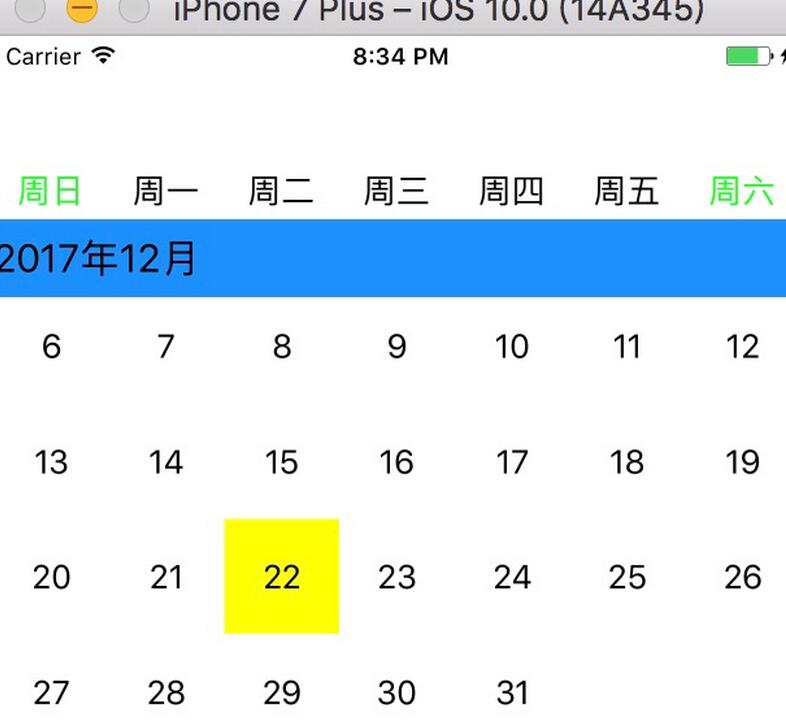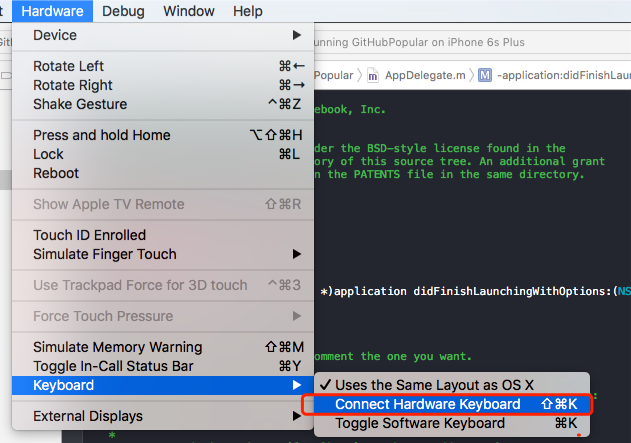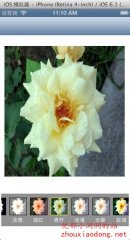iOS自定義日歷控件的簡單實現過程
編輯:IOS開發綜合
因為程序要求要插入一個日歷控件,該空間的要求是從當天開始及以後的六個月內的日歷,上網查資料基本上都說只要獲取兩個條件(當月第一天周幾和本月一共有多少天)就可以實現一個簡單的日歷,剩下的靠自己的簡單邏輯就OK了,下面開始自己從開始到完成的整個過程
1.首先做NSDate類目,擴展一些方法讓日期之間轉換更加方便
#import <Foundation/Foundation.h> @interface NSDate (LYWCalendar) #pragma mark - 獲取日 - (NSInteger)day:(NSDate *)date; #pragma mark - 獲取月 - (NSInteger)month:(NSDate *)date; #pragma mark - 獲取年 - (NSInteger)year:(NSDate *)date; #pragma mark - 獲取當月第一天周幾 - (NSInteger)firstWeekdayInThisMonth:(NSDate *)date; #pragma mark - 獲取當前月有多少天 - (NSInteger)totaldaysInMonth:(NSDate *)date; @end
下面一一實現這些方法
#import "NSDate+LYWCalendar.h"
@implementation NSDate (LYWCalendar)
/**
*實現部分
*/
#pragma mark -- 獲取日
- (NSInteger)day:(NSDate *)date{
NSDateComponents *components = [[NSCalendar currentCalendar] components:(NSCalendarUnitYear | NSCalendarUnitMonth | NSCalendarUnitDay) fromDate:date];
return components.day;
}
#pragma mark -- 獲取月
- (NSInteger)month:(NSDate *)date{
NSDateComponents *components = [[NSCalendar currentCalendar] components:(NSCalendarUnitYear | NSCalendarUnitMonth | NSCalendarUnitDay) fromDate:date];
return components.month;
}
#pragma mark -- 獲取年
- (NSInteger)year:(NSDate *)date{
NSDateComponents *components = [[NSCalendar currentCalendar] components:(NSCalendarUnitYear | NSCalendarUnitMonth | NSCalendarUnitDay) fromDate:date];
return components.year;
}
#pragma mark -- 獲得當前月份第一天星期幾
- (NSInteger)firstWeekdayInThisMonth:(NSDate *)date{
NSCalendar *calendar = [NSCalendar currentCalendar];
//設置每周的第一天從周幾開始,默認為1,從周日開始
[calendar setFirstWeekday:1];//1.Sun. 2.Mon. 3.Thes. 4.Wed. 5.Thur. 6.Fri. 7.Sat.
NSDateComponents *comp = [calendar components:(NSCalendarUnitYear | NSCalendarUnitMonth | NSCalendarUnitDay) fromDate:date];
[comp setDay:1];
NSDate *firstDayOfMonthDate = [calendar dateFromComponents:comp];
NSUInteger firstWeekday = [calendar ordinalityOfUnit:NSCalendarUnitWeekday inUnit:NSCalendarUnitWeekOfMonth forDate:firstDayOfMonthDate];
//若設置從周日開始算起則需要減一,若從周一開始算起則不需要減
return firstWeekday - 1;
}
#pragma mark -- 獲取當前月共有多少天
- (NSInteger)totaldaysInMonth:(NSDate *)date{
NSRange daysInLastMonth = [[NSCalendar currentCalendar] rangeOfUnit:NSCalendarUnitDay inUnit:NSCalendarUnitMonth forDate:date];
return daysInLastMonth.length;
}
接下來就要寫邏輯部分了,在ViewController裡面實現,先說思想,首先想到的是用collectionView,但是每個月天數不一樣在日歷中的顯示就不一樣,有時候有五行有時候有六行,既然要用自動填充就必須考慮到這一點,下面是代碼實現
#import "ViewController.h" #import "Macro.h" #import "NSDate+LYWCalendar.h" #import "LYWCollectionViewCell.h" #import "LYWCollectionReusableView.h"
定義一些全局變量
static NSString *cellID = @"cellID";
static NSString *headerID = @"headerID";
static NSString *footerID = @"footerID";
@implementation ViewController
{
//自動布局
UICollectionViewFlowLayout *_layout;
//表格視圖
UICollectionView *_collectionView;
//當月第一天星期幾
NSInteger firstDayInMounthInWeekly;
NSMutableArray *_firstMounth;
//容納六個數組的數組
NSMutableArray *_sixArray;
}
//定義星期視圖,若為周末則字體顏色為綠色
self.automaticallyAdjustsScrollViewInsets = NO;//關閉自動適應
NSArray *weekTitleArray = @[@"周日",@"周一",@"周二",@"周三",@"周四",@"周五",@"周六"];
for (int i = 0; i < weekTitleArray.count; i++) {
UILabel *weekTitleLable = [[UILabel alloc]initWithFrame:CGRectMake(i * ((ScreenWidth/(weekTitleArray.count))), 64, ScreenWidth/(weekTitleArray.count ), 30)];
if (i == 0 || i == 6) {
weekTitleLable.textColor = [UIColor greenColor];
}else{
weekTitleLable.textColor = [UIColor blackColor];
}
weekTitleLable.text = [weekTitleArray objectAtIndex:i];
weekTitleLable.textAlignment = NSTextAlignmentCenter;
[self.view addSubview:weekTitleLable];
}
//設置collectionView及自動布局,代理方法尤為重要 _layout = [[UICollectionViewFlowLayout alloc]init]; //頭部始終在頂端 _layout.sectionHeadersPinToVisibleBounds = YES; //頭部視圖高度 _layout.headerReferenceSize = CGSizeMake(414, 40); _layout.minimumLineSpacing = 0; _layout.minimumInteritemSpacing = 0; _collectionView = [[UICollectionView alloc]initWithFrame:CGRectMake(0, 64 + 30, ScreenWidth, ScreenHeight - 64 - 30) collectionViewLayout:_layout]; _collectionView.backgroundColor = [UIColor whiteColor]; //注冊表格 [_collectionView registerClass:[LYWCollectionViewCell class] forCellWithReuseIdentifier:cellID]; //注冊頭視圖 [_collectionView registerClass:[LYWCollectionReusableView class] forSupplementaryViewOfKind:UICollectionElementKindSectionHeader withReuseIdentifier:headerID]; //注冊尾視圖 // [_collectionView registerClass:[UICollectionReusableView class] forCellWithReuseIdentifier:footerID]; _collectionView.delegate = self; _collectionView.dataSource = self; [self.view addSubview:_collectionView];
邏輯部分,這裡有個比較長的三項表達式
(daysInMounth > 29 && (firstDayInThisMounth == 6 || firstDayInThisMounth ==5) ? 42 : 35)
就是日歷到底是六行還是七行,這就要根據日歷的特性來判斷了,如果當月天數大於29天並且當月第一天星期六(以這個程序的准則)或者星期天是返回六行剩下的返回三行,也有可能返回四行的,但是就這個程序來說是不可能的也就不需要做判斷了
//NumberMounthes 為宏定義,表示要顯示月的個數,程序要求是六個月,所以宏定義為六
//#define NumberMounthes 6 //想要展示的月數
//創建六個數組,並將這六個數組裝入大數組中
_sixArray = [[NSMutableArray alloc]init];
for (int i = 0; i < NumberMounthes ; i++ ) {
NSMutableArray *array = [[NSMutableArray alloc]init];
[_sixArray addObject:array];
}
//為六個數組寫入每個月的日歷信息
for (int i = 0 ; i < NumberMounthes; i++) {
//獲取月份
int mounth = ((int)[currentDate month:currentDate] + i)%12;
NSDateComponents *components = [[NSDateComponents alloc]init];
//獲取下個月的年月日信息,並將其轉為date
components.month = mounth;
components.year = 2016 + mounth/12;
components.day = 1;
NSCalendar *calendar = [NSCalendar currentCalendar];
NSDate *nextDate = [calendar dateFromComponents:components];
//獲取該月第一天星期幾
NSInteger firstDayInThisMounth = [nextDate firstWeekdayInThisMonth:nextDate];
//該月的有多少天daysInThisMounth
NSInteger daysInThisMounth = [nextDate totaldaysInMonth:nextDate];
NSString *string = [[NSString alloc]init];
for (int j = 0; j < (daysInMounth > 29 && (firstDayInThisMounth == 6 || firstDayInThisMounth ==5) ? 42 : 35) ; j++) {
if (j < firstDayInThisMounth || j > daysInThisMounth + firstDayInThisMounth - 1) {
string = @"";
[[_sixArray objectAtIndex:i]addObject:string];
}else{
string = [NSString stringWithFormat:@"%ld",j - firstDayInThisMounth + 1];
[[_sixArray objectAtIndex:i]addObject:string];
}
}
}
下面是代理方法
//這兩個不用說,返回cell個數及section個數
- (NSInteger)collectionView:(UICollectionView *)collectionView numberOfItemsInSection:(NSInteger)section{
return [[_sixArray objectAtIndex:section] count];
}
- (NSInteger)numberOfSectionsInCollectionView:(UICollectionView *)collectionView{
return _sixArray.count;
}
//這裡是自定義cell,非常簡單的自定義
- (UICollectionViewCell *)collectionView:(UICollectionView *)collectionView cellForItemAtIndexPath:(NSIndexPath *)indexPath{
LYWCollectionViewCell *cell = [collectionView dequeueReusableCellWithReuseIdentifier:cellID forIndexPath:indexPath];
UIView *blackgroundView = [[UIView alloc]initWithFrame:CGRectMake(0, 0, cell.frame.size.width, cell.frame.size.height)];
blackgroundView.backgroundColor = [UIColor yellowColor];
cell.dateLable.text = [[_sixArray objectAtIndex:indexPath.section]objectAtIndex:indexPath.row];
NSDate *date = [[NSDate alloc]init];
NSInteger day = [date day:date];
//設置單擊後的顏色
cell.selectedBackgroundView = blackgroundView;
return cell;
}
自定義cell .h
#import <UIKit/UIKit.h> @interface LYWCollectionViewCell : UICollectionViewCell @property (nonatomic,strong) UILabel *dateLable; - (instancetype)initWithFrame:(CGRect)frame; @end
.m
#import "LYWCollectionViewCell.h"
@implementation LYWCollectionViewCell
- (instancetype)initWithFrame:(CGRect)frame{
if (self == [super initWithFrame:frame]) {
_dateLable = [[UILabel alloc] initWithFrame:self.bounds];
[_dateLable setTextAlignment:NSTextAlignmentCenter];
[_dateLable setFont:[UIFont systemFontOfSize:17]];
_dateLable.textColor = [UIColor blackColor];
[self addSubview:_dateLable];
}
return self;
}
@end
接著代理
//cell大小及間距
- (CGSize)collectionView:(UICollectionView *)collectionView layout:(UICollectionViewLayout *)collectionViewLayout sizeForItemAtIndexPath:(NSIndexPath *)indexPath{
return CGSizeMake(ScreenWidth/7, ScreenWidth/7);
}
- (UIEdgeInsets)collectionView:(UICollectionView *)collectionView layout:(UICollectionViewLayout *)collectionViewLayout insetForSectionAtIndex:(NSInteger)section{
return UIEdgeInsetsMake(0, 0, 0, 0);
}
既然有日歷,總得顯示哪年哪月吧,前面已經注冊表頭視圖了,這裡只需要實現以下代理方法即可
collectionView有點不同其頭視圖也有單獨的類,和cell一樣先自定義headCell,也是非常簡單的自定義
.h文件
#import <UIKit/UIKit.h> @interface LYWCollectionReusableView : UICollectionReusableView @property (nonatomic,strong) UILabel *dateLable; - (instancetype)initWithFrame:(CGRect)frame; @end
.m文件
#import "LYWCollectionReusableView.h"
@implementation LYWCollectionReusableView
- (instancetype)initWithFrame:(CGRect)frame{
if (self == [super initWithFrame:frame]) {
_dateLable = [[UILabel alloc] initWithFrame:self.bounds];
[_dateLable setTextAlignment:NSTextAlignmentLeft];
[_dateLable setFont:[UIFont systemFontOfSize:20]];
_dateLable.textColor = [UIColor blackColor];
[self addSubview:_dateLable];
}
return self;
}
@end
接著代理方法,這裡也有個三項判斷式,和上面的大同小異,主要是防止12月顯示為0月
- (UICollectionReusableView *)collectionView:(UICollectionView *)collectionView viewForSupplementaryElementOfKind:(NSString *)kind atIndexPath:(NSIndexPath *)indexPath{
if (kind == UICollectionElementKindSectionHeader) {
LYWCollectionReusableView *headerRV = [collectionView dequeueReusableSupplementaryViewOfKind:kind withReuseIdentifier:headerID forIndexPath:indexPath];
//自定義藍色
headerRV.backgroundColor = DODGER_BLUE;
NSDate *currentDate = [[NSDate alloc]init];
NSInteger year = ([currentDate month:currentDate] + indexPath.section)/12 + 2016;
NSInteger mounth = ([currentDate month:currentDate] + indexPath.section) % 12 == 0 ? 12 : ([currentDate month:currentDate] + indexPath.section)%12;
headerRV.dateLable.text = [NSString stringWithFormat:@"%ld年%ld月",year,mounth];
return headerRV;
}else{
return nil;
}
}
還是代理,處理選中效果,選中的為黃色
- (void)collectionView:(UICollectionView *)collectionView didSelectItemAtIndexPath:(NSIndexPath *)indexPath{
LYWCollectionViewCell *cell = [self collectionView:_collectionView cellForItemAtIndexPath:indexPath];
NSDate *currentDate = [[NSDate alloc]init];
//打印當前日期
if (![cell.dateLable.text isEqualToString:@""]) {
NSInteger year = ([currentDate month:currentDate] + indexPath.section)/12 + 2016;
NSInteger mounth = ([currentDate month:currentDate] + indexPath.section)%12;
NSInteger day = [cell.dateLable.text intValue];
NSLog(@"%ld年%02ld月%02ld日",year,mounth,day);
}
//排除空值cell
//獲取月份
NSInteger mounth = ([currentDate month:currentDate] + indexPath.section) % 12 == 0 ? 12 : ([currentDate month:currentDate] + indexPath.section)%12;
NSDateComponents *components = [[NSDateComponents alloc]init];
components.month = mounth;
components.year = 2016 + mounth/12;
components.day = 1;
NSCalendar *calendar = [NSCalendar currentCalendar];
NSDate *nextDate = [calendar dateFromComponents:components];
//獲取該月第一天星期幾
NSInteger firstDayInThisMounth = [nextDate firstWeekdayInThisMonth:nextDate];
//該月的有多少天daysInThisMounth
NSInteger daysInThisMounth = [nextDate totaldaysInMonth:nextDate];
if ((indexPath.row < firstDayInThisMounth || indexPath.row > daysInThisMounth + firstDayInThisMounth - 1)){
//如果點擊空表格則單擊無效
[collectionView cellForItemAtIndexPath:indexPath].userInteractionEnabled = NO;
[collectionView reloadData];
}
}
最後展示很爛的效果圖:

以上就是本文的全部內容,希望對大家的學習有所幫助,也希望大家多多支持本站。
- 上一頁:iOS App引導頁開發教程
- 下一頁:12個iOS技術面試題及答案總結
相關文章
+



